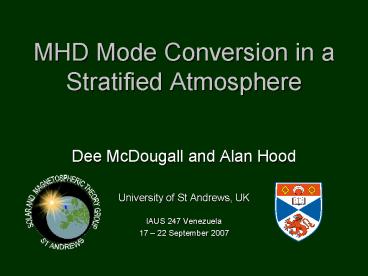MHD Mode Conversion in a Stratified Atmosphere - PowerPoint PPT Presentation
1 / 13
Title:
MHD Mode Conversion in a Stratified Atmosphere
Description:
Investigate propagation from high- to low- plasma. Solutions ... Fast wave is evanescent. We derive wave equations from the Ideal, linearised MHD equations. ... – PowerPoint PPT presentation
Number of Views:72
Avg rating:3.0/5.0
Title: MHD Mode Conversion in a Stratified Atmosphere
1
MHD Mode Conversion in a Stratified Atmosphere
- Dee McDougall and Alan Hood
- University of St Andrews, UKIAUS 247 Venezuela
- 17 22 September 2007
2
- Zhugzhda (1979) Zhugzhda and Dzhalilov (1981,
1982) Cally (2001). - Investigate propagation from high- to low-ß
plasma. - Solutions found for harmonic waves.
- We examine propagation from low- to high-ß
plasma. - We drive on the upper boundary.
- Predominantly a slow wave.
- Fast wave is evanescent.
3
- We derive wave equations from the Ideal,
linearised MHD equations. - Fast and slow modes coupled via the horizontal
wave number - If there is no mode conversion.
- Equations are solved numerically using the
MacCormack scheme.
4
Numerical Simulations Isothermal
- Strong exponential behaviour.
- Masks what is happening around conversion region.
- Now clear that mode conversion is occurring where
the sound and Alfvén speeds are equal.
5
- In high ß we see the fast wave propagating ahead
(transmitted wave). - Slow wave lags behind and is visible as
interference (converted wave). - Amplitude of transmitted wave may be compared to
the incident wave to quantify the transmission.
6
- Conversion occurs at where
- Single wave mode will have the same properties in
both high and low ß. - When we drive a slow wave in low ß
- Transmitted wave is the fast wave.
- Converted wave is the slow wave.
7
- Using WKB method we may expand and in
inverse powers of assuming that - Substituting these expansions into the wave
equations gives solutions valid away from the
mode-conversion region. - and are the conversion and transmission
coefficients respectively.
8
- To solve our wave equations around the
mode-conversion region we follow the method
developed by Cairns and Lashmore-Davies (1983). - Method is valid under the assumptions
, - Writing the wave equations in the form
- the transmission coefficient is given by
- the conversion coefficient is given by
9
- Under the assumptions, if we make the
transformation and expand about
the conversion region the wave equations become - So the conversion and transmission coefficients
are given by
- On comparing with the results of the
numerical simulations we find excellent
agreement. - Work to be published in Solar Physics, McDougall
and Hood (2007, in press).
10
Non-Isothermal Atmosphere
- We may follow exactly the same analysis process
for a non-isothermal atmosphere.
- We choose a tanh profile to model the steep
temperature gradient at the transition region. - .
- We set in the centre of the
temperature gradient.
11
- Using a WKB analysis the behaviour away from the
mode-conversion region is given as - This allows us to transform the velocity so that
the incident amplitude is constant
12
- Following Cairns and Lashmore-Davies (1983)
around the mode-conversion region, we find
conversion and transmission coefficients
- As before, we can compare the transmission
predicted to the numerical simulations.
13
Conclusions and Future Work
- Using various analytical techniques we have found
conversion and transmission coefficients which
accurately quantify mode conversion. - It turns out that the conversion and transmission
coefficients are the same regardless of the
chosen temperature profile. - We plan to investigate the same phenomenon in
more complex magnetic topologies, such as around
2D null points, extending on work done by
McLaughlin and Hood (2006).

